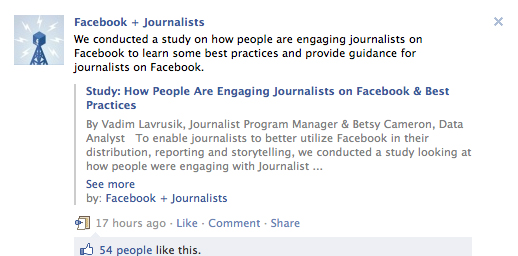Facebook has published a study on how users interact with journalists’ pages on the social networking site.
The research also analysed how users use news organisations’ Facebook pages. Those results will be published shortly.

The main highlights from the study, published on the Facebook for Journalists page, suggest journalists with Facebook pages should take note of the following facts:
- Starting the conversation: Posts that include a question or call to action from the journalist received the highest amount of feedback;
- Personal analysis is effective: Posts that included the journalist’s analysis and personal reflections had 20 per cent more referral clicks than that of an average post;
- Images work: Photos received 50 per cent more likes than non-photo posts, and journalists who shared links that included a thumbnail image in the link preview received 65 per cent more likes and 50 per cent more comments than posts that did not include images.
Facebook’s report is co-authored by journalist programme manager at Facebook Vadim Lavrusik, who spoke to Journalism.co.uk for this podcast on how journalists can best use Facebook pages and for this guide on how to set up a successful Facebook page as a journalist.
Other findings of the report:
- Posts that asked questions or sought user input: +64 per cent;
- Call to read or take a closer look: +37 per cent;
- Personal reflections or behind-the-scenes posts: +25 per cent;
- Posts with catchy/clever language or tone: +18 per cent.
What is the most effective post length?
On average, meaty posts from journalists get more feedback via comments and likes. The analysis showed that four-line postings received a 30 per cent increase in feedback over average posts and five-line postings showed a 60 per cent increase in feedback over average posts. However, one-line posts show the greatest fluctuation, receiving the highest maximum feedback observed, at 15 times higher than the average post. Five-line posts were a close second, showing a maximum of around 10 times the average post. For journalists posting teasers for links or status updates on their pages, this means both short and long posts can yield results but meatier posts on average generate more feedback overall.
Is it worth posting photos?
The research also shows it is worth ensuring every news story has an image.
Journalists who shared links that included a thumbnail image in the link preview on their page wall saw a 65 per cent increase in likes and 50 per cent increase in comments on those posts.
What types of story gets the most interaction?
The research on the type of stories that result in the greatest number of click-throughs and the highest reader engagement is revealing.
Engagement by story type: Posts about education, politics and behind-the-scenes insights and analysis from journalists received a higher amount of feedback on average. Education posts got two times more likes, politics received both 1.7 times more likes and 1.6 times more comments, and a journalist sharing their thoughts had 1.4 times more likes.
Referral clicks and story type: International news stories had 70 per cent more referral clicks than that of an average post. For example: “For 60 years, Pakistan’s military has focused obsessively on its rivalry with India. Large elements within that military appear to be switching obsessions…” – Fareed Zakaria, CNN;
Stories about politics received 60 per cent more referral clicks. For example: “I’m sitting down with President Obama tomorrow for an exclusive interview – click below and tell me what you think I should ask.” – George Stephanopoulos, ABC;
Posts that included the journalist’s analysis or personal reflections received 20 per cent more referral clicks than an average post. For example: For all of you high school students accepted into college – congratulations, but think about deferring for a year and taking a ‘gap year’ – I did…” – Nicholas Kristof, the New York Times;
Daily feedback and referral clicks: Journalists received the highest amount of feedback later in the week. Thursday, Friday, Saturday and Sunday had the highest amount of feedback – with Sunday receiving the highest amount of feedback at 25 per cent more likes and 8 per cent more comments above average. Referral clicks were above average Wednesday, Thursday and Saturday – with links getting 85 per cent more clicks on Saturday and 37 per cent more on Wednesday than an average post;
This part of the study focuses on the US, which spans several time zones, but the following times are worth noting:
Hourly feedback: Readers are active throughout the day. Feedback spikes occurred on journalist pages at the start of the day (7am and 8am showing a 30-40 per cent increase); late in the morning (10am received 40 per cent increase in feedback); later in the workday (4 and 5pm showing 40 per cent and 100 per cent increases); and on into the evening hours (midnight getting 30 per cent increase and 2am getting 20 per cent increase).
Poynter’s report on the Facebook study – Facebook data show 7 keys to maximum engagement for journalists – explains the scope of the research:
For those curious about the methodology, Facebook’s Vadim Lavrusik tells me they sampled 25 pages of local, national and international journalists, across various types of media. Data was collected over a two-week period.

